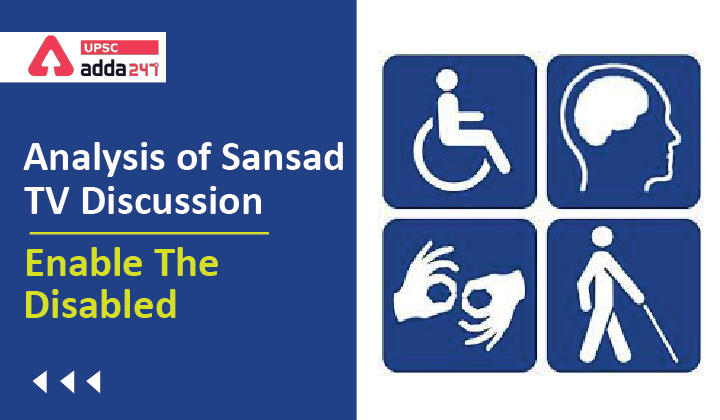Table of Contents
Context
The world population is over 7 billion – and more than one billion people (or around 15% of the world’s population) live with some or the other form of disability – 80% of them in developing countries.
Background
- To achieve the Sustainable Development Goals 2030, the world has to build an inclusive and just society for everyone, leaving no one behind.
- The International Day of Persons with Disabilities, on the 3rd of December aims to promote the rights and well-being of persons with disabilities in all spheres of society and development and to increase awareness about the situation of persons with disabilities in every aspect of political, social, economic and cultural life.
What is Disability?
Disability refers to the interaction between individuals with a health condition (e.g., cerebral palsy, Down syndrome and depression) and personal and environmental factors (e.g., negative attitudes, inaccessible transportation and public buildings, and limited social supports).
Key facts
- Over 1 billion people live with some form of disability.
- The number of people with disability are dramatically increasing. This is due to demographic trends and increases in chronic health conditions, among other causes.
- Almost everyone is likely to experience some form of disability – temporary or permanent – at some point in life.
- People with disabilities are disproportionately affected during the COVID-19 pandemic.
- When people with disabilities access health care, they often experience stigma and discrimination and receive poor quality services.
- There is an urgent need to scale up disability inclusion in all levels of the health system, particularly primary health care.
- The number of people experiencing disability is increasing due to a rise in chronic health conditions and population ageing.
- People with disabilities also face barriers, stigmatization and discrimination when accessing health and health-related services and strategies.
- Disability is a development priority because of its higher prevalence in lower-income countries and because disability and poverty reinforce and perpetuate one another.
The theme of this years’ International Day of Persons with Disabilities
- Every year, the International Day of Persons with Disabilities is observed with a particular theme.
- This year, the theme for International Day of Persons with Disabilities 2021 is ‘Leadership and participation of persons with disabilities toward an inclusive, accessible and sustainable post-COVID 19 world’.
- The UN has adopted this theme to highlight the issues faced by disabled people during the global pandemic.
Article 25 of the UN Convention on the Rights of Persons with Disabilities (CRPD)
- The Convention on the Rights of Persons with Disabilities (CRPD), was adopted in the year 2006.
- The CRDP aims at working towards creating equal opportunities for persons with disabilities through the implementation of the 2030 Agenda for Sustainable Development.
- Article 25 reinforces the right of persons with disabilities to attain the highest standard of health, without discrimination.
- However, the reality is that few countries provide adequate quality services for people with disabilities.
GOI Initiatives for empowering persons with disabilities
- The Government has enacted the Right to Persons with Disabilities Act, 2016 which came into effect from 19.04.2017. The Act provides for 4% reservation in government jobs for persons with disabilities.
- In January 2021, the Ministry has identified 3566 posts suitable for persons with disabilities.
- The Sugamya Bharat Abhiyan (Accessible India Campaign) was launched by the Government on 03.12.2015 to provide universal accessibility to persons with disabilities so that they can live a meaningful life with dignity. Public buildings, transport systems and information and communication technology have been included in this campaign.
- The Government has set up the Indian Sign Language Research and Training Centre to promote the empowerment of hearing-impaired persons and to create sign language in India. The Institute, among other functions, is continuously preparing sign language dictionaries that have so far included more than 10,000 words.
- The Government is implementing a Unique Disability Identity Card project with the objective of creating a National Database for Persons with Disabilities.
- The Government is also establishing a Centre for Disability Sports Centre at Gwalior, Madhya Pradesh, which will be completed by mid-2022.
- Department of Empowerment of Persons with Disabilities also assists disabled persons under the various flagship schemes/programme.
- On the occasion of the International Day of Persons with Disabilities i.e. 3rd December, the Department of Empowerment of Persons with Disabilities (Divyangjan), Ministry of Social Justice and Empowerment confers National Awards on Individuals, Institutions, Organizations, State/District etc for their outstanding achievements and work done towards empowerment of Persons with Disabilities every year.
Conclusion
The world is providing opportunities to shape an inclusive future for persons with disabilities, but still the challenges and barriers they face are huge and require accelerated steps to reduce inequalities.



 TSPSC Group 1 Question Paper 2024, Downl...
TSPSC Group 1 Question Paper 2024, Downl...
 TSPSC Group 1 Answer key 2024 Out, Downl...
TSPSC Group 1 Answer key 2024 Out, Downl...
 UPSC Prelims 2024 Question Paper, Downlo...
UPSC Prelims 2024 Question Paper, Downlo...




